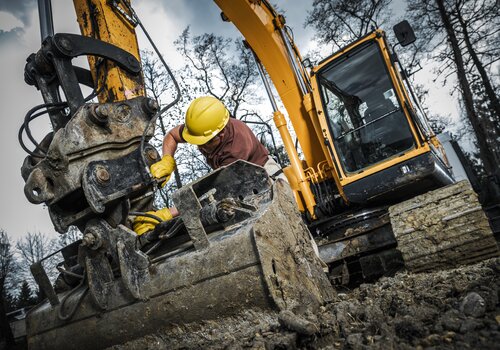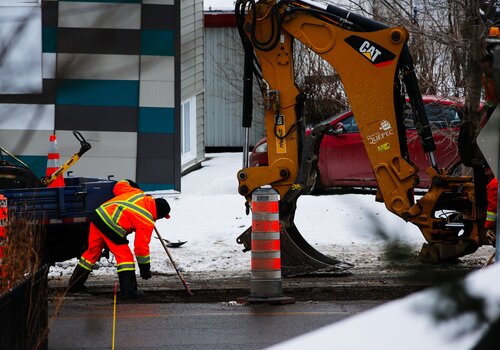If you’ve been in the construction industry for a while, you know that having the right machines at your disposal is non-negotiable. But it’s not just about owning or renting the biggest and most powerful machines; it’s about understanding their intricacies, when to leverage each one to its fullest and how to optimize their usage on the job site. Whether you’re a project manager looking to refine operational efficiency or a seasoned operator aiming to get the most out of your equipment, here’s a closer look at the top five construction machines you should know inside and out—and how to make them work harder for you.
1. EXCAVATORS: THE JACK-OF-ALL-TRADES
Excavators are the cornerstone of any major construction site, and for good reason. Their versatility is unmatched—they’re used for everything from heavy digging and trenching to demolition and material handling. But as an experienced contractor, you know that not all excavators are created equal.
Pro Tips:
- Maximize Efficiency with Attachments: If you’re still sticking to just buckets, you’re missing out. Attachments like hydraulic breakers, augers, and thumbs can turn your excavator into a multi-functional powerhouse. For instance, using a quick coupler allows operators to switch between a digging bucket and a hydraulic hammer seamlessly, saving time and boosting productivity.
- Keep an Eye on Load-Sensing Hydraulics: Modern excavators come equipped with load-sensing hydraulics, which adjust power output based on the load. This feature can significantly improve fuel efficiency and performance, so ensure your operators are trained to understand and utilize it.
- Safety First: The buckets on evacuators are incredibly powerful and can save time and money on almost any project site, but there are dangers if operators are not properly trained. Check out NIOAH’s fact sheet that can help keep everyone safe.
2. CRANES: PRECISION AND POWER IN ONE PACKAGE
Cranes are not just for lifting—they’re for strategic positioning of heavy loads with precision. From tower cranes dominating city skylines to mobile cranes navigating tight job sites, these machines demand expertise and foresight.
Pro Tips:
- Plan for Wind Conditions: Wind speed and direction can make or break your lift plan, especially with tower cranes. Make sure your crew has a reliable anemometer and understands how to interpret readings to decide when it’s safe to operate.
- Upgrade with Smart Technology: The latest cranes come with anti-sway systems and load-monitoring tech that provide real-time data to operators, reducing human error and increasing safety. Investing in these upgrades, or renting cranes that feature them, can elevate your project’s efficiency and reduce risk.
- Maintain Regular Inspections: It’s easy to overlook, but advanced contractors know that crane checks go beyond simple visual inspections. Pay attention to boom connections and pulleys, as these high-stress components can wear faster than expected.
It’s not just about owning or renting the biggest and most powerful machines; it’s about understanding their intricacies.
3. BULLDOZERS: THE EARTH MOVERS
Bulldozers are the muscle of the job site. Their primary role might be to move enormous amounts of soil and debris, but savvy contractors know they’re just as valuable for fine grading and site preparation.
Pro Tips:
- Use GPS and Grade Control Systems: If you’re not using GPS-enabled grade control, you’re leaving efficiency on the table. These systems allow operators to work with greater accuracy, reducing the need for multiple passes and manual rework.
- Adjust Track Tension Regularly: Track tension is crucial for maintaining the machine’s power and avoiding unnecessary wear. Too tight, and you’re putting stress on the undercarriage; too loose, and you risk de-tracking. Train your operators to check and adjust tension frequently, especially when working on varied terrain.
4. LOADERS: MORE THAN JUST LOADING
Whether you’re running a wheel loader, skid steer or backhoe loader, understanding how to push these machines to their limits can set you apart from the competition.
Pro Tips:
- Optimize Load Cycles: Experienced operators know that a quick, smooth load cycle can increase productivity significantly. Ensure that operators know how to load materials efficiently and balance the bucket load to reduce spillage and fuel consumption.
- Choose the Right Tires: For wheel loaders, the type of tire matters. L-3 tires are good for general use, but if you’re working in rocky conditions, L-5 tires with a deeper tread can reduce downtime caused by punctures.
- Utilize Boom Suspension Systems: If you’re working on rough terrain, boom suspension systems can prevent material loss during transport and extend the life of your loader’s boom. It’s an overlooked feature but worth the investment for jobs involving heavy loads and uneven surfaces.
5. COMPACTORS: THE STABILITY MAKERS
Compactors are often underestimated, but seasoned contractors understand their role in creating a stable foundation. Whether it’s a vibratory roller or a pneumatic tire roller, compactors ensure that structures don’t settle or shift over time.
Pro Tips:
- Watch Out for Over-Compaction: Over-compacting soil can be just as problematic as under-compaction, leading to structural issues down the road. Ensure that operators are trained to recognize when compaction is sufficient, especially when working with granular materials.
- Leverage Intelligent Compaction (IC) Systems: Modern compactors come with IC systems that use sensors and GPS to give real-time feedback on compaction levels. If you haven’t upgraded yet, consider renting a model with this feature for large projects.
- Maintain Uniform Coverage: Uneven passes can create weak spots. Use overlapping techniques and monitor for even coverage, particularly when compacting large areas for road or foundation work.
FINAL THOUGHTS
Mastering these machines isn’t just about knowing how to operate them; it’s about leveraging every advantage they offer. From utilizing attachments on excavators to understanding the finer points of load management with cranes, these tips can help you push the limits of what’s possible on your job site.
Staying updated on the latest technologies and best practices, like smart crane systems and GPS-based graders, can be game changers. Whether you’re fine-tuning your approach or training your team, mastery of these top machines will set your projects apart, ensuring they are completed on time, within budget and to the highest standard.
Photo credit: KADMY/BIGSTOCKPHOTO.COM












